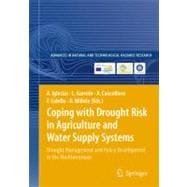
| Challenges to Drought Management in Mediterranean Countries | |
| Drought Monitoring as a Component of Drought Preparedness Planning | p. 3 |
| Soft Law Principles for Improving Drought Management in Mediterranean Countries | p. 21 |
| A Checklist for Drought Policy Development | p. 37 |
| An Environmental Focus on Drought: The Water Framework Directive | p. 43 |
| Guidelines to Develop Drought Management Plans | p. 55 |
| Methods and Approaches for Drought Management | |
| Drought Characterisation in the Mediterranean | p. 69 |
| A Paradigm for Applying Risk and Hazard Concepts in Proactive Planning | p. 81 |
| Assessment of Drought Risk in Water Supply Systems | p. 93 |
| Mathematical Models for Reservoir Operation in Tunisia | p. 111 |
| Risk Management Instruments Supporting Drought Planning and Policy | p. 133 |
| Methods for Evaluating Social Vulnerability to Drought | p. 153 |
| Methods for Social Participation and Conflict Resolution | p. 161 |
| Learning from the Case Studies | |
| Development of Drought Management Plans in Spain | p. 175 |
| Characterizing Drought Risk in a Sicilian River Basin | p. 187 |
| The Role of Groundwater During Drought | p. 221 |
| Drought Severity Thresholds and Drought Management in Greece | p. 243 |
| Using and Testing Drought Indicators | p. 257 |
| Drought Management in the Urban Water Supply System of Canal de Isabel II, Spain | p. 273 |
| The Role of Non-Conventional and Lower Quality Water for the Satisfaction of the Domestic Needs in Drought Management Plans | p. 287 |
| Glossary of Terms and Concepts | p. 299 |
| Index | p. 311 |
| Table of Contents provided by Ingram. All Rights Reserved. |
The New copy of this book will include any supplemental materials advertised. Please check the title of the book to determine if it should include any access cards, study guides, lab manuals, CDs, etc.
The Used, Rental and eBook copies of this book are not guaranteed to include any supplemental materials. Typically, only the book itself is included. This is true even if the title states it includes any access cards, study guides, lab manuals, CDs, etc.